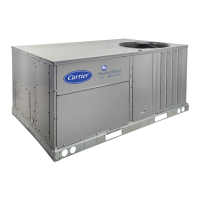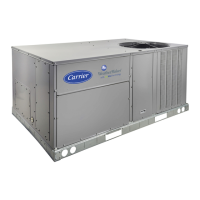64
UNOCCUPIED ECONOMIZER FREE COOLING
This Free Cooling function is used to start the supply fan and
use the economizer to bring in outside air when the outside
temperature is cool enough to pre-cool the space. This is done
to delay the need for mechanical cooling when the system en-
ters the occupied period. This function requires the use of a
space temperature sensor.
When configured, the economizer will modulate during an un-
occupied period and attempt to maintain space temperature to
the occupied cooling setpoint. Once the need for cooling has
been satisfied during this cycle, the fan will be stopped.
Configuring the economizer for Unoccupied Economizer Free
Cooling is done in the UEFC group. There are three configura-
tion options, FC.CF, FC.TM and FC.LO.
Unoccupied Economizer Free Cooling Configuration (FC.CF)
This option is used to configure the type of unoccupied econo-
mizer free cooling control that is desired.
0 = disable unoccupied economizer free cooling
1 = perform unoccupied economizer free cooling as available
during the entire unoccupied period.
2 = perform unoccupied economizer free cooling as available,
FC.TM minutes before the next occupied period.
Unoccupied Economizer Free Cooling Time Configuration
(FC.TM)
This option is a configurable time period, prior to the next oc-
cupied period, that the control will allow unoccupied econo-
mizer free cooling to operate. This option is only applicable
when FC.CF = 2.
Unoccupied Economizer Free Cooling Outside Lockout Tem-
perature (FC.L.O)
This configuration option allows the user to select an outside-
air temperature below which unoccupied free cooling is not al-
lowed. This is further explained in the logic section.
Unoccupied Economizer Free Cooling Logic
The following qualifications that must be true for unoccupied
free cooling to operate:
• Unit configured for an economizer
• Space temperature sensor enabled and sensor reading
within limits
• Unit is in the unoccupied mode
• FC.CF set to 1 or FC.CF set to 2 and control is within
FC.TM minutes of the next occupied period
• Not in the Temperature Compensated Start Mode
• Not in a cooling mode
• Not in a heating mode
• Not in a tempering mode
• Outside-air temperature sensor reading within limits
• Economizer would be allowed to cool if the fan were re-
quested and in a cool mode
•OAT > FC.L.O (1.0°F hysteresis applied)
• Unit not in a fire smoke mode
• No fan failure when configured to for unit to shut down on
a fan failure
If all of the above conditions are satisfied:
Unoccupied Economizer Free Cooling will start when both of
the following conditions are true:
{SPT > (OCSP + 2)} AND {SPT > (OAT + 8)}
The Unoccupied Economizer Free Cooling Mode will stop
when either of the following conditions are true:
{SPT < OCSP} OR {SPT < (OAT + 3)} where SPT = Space
Temperature and OCSP = Occupied Cooling Setpoint.
When the Unoccupied Economizer Free Cooling mode is ac-
tive, the supply fan is turned on and the economizer damper
modulated to control to the supply air setpoint (Setpoints
SASP) plus any supply air reset that may be applied (Inputs
RSET
SA.S.R).
FDD CONFIGURATIONS
Log Title 24 Faults (LOG.F)
Enables Title 24 detection and logging of mechanically discon-
nected actuator faults.
T24 Econ Move Detect (EC.MD)
Detects the amount of change required in the reported position
before economizer is detected as moving.
T24 Econ Move SAT Test (EC.ST)
The minimum amount the economizer must move in order to
trigger the test for a change in SAT. The economizer must
move at least EC.ST % before the control will attempt to deter-
mine whether the actuator is mechanically disconnected.
T24 Econ Move SAT Change (S.CHG)
The minimum amount (in degrees F) SAT is expected to
change based on economizer position change of EC.ST.
T24 Econ RAT-OAT Diff (E.SOD)
The minimum amount (in degrees F) between RAT (if avail-
able) or SAT (with economizer closed and fan on) and OAT to
perform mechanically disconnected actuator testing.
T24 Heat/Cool End Delay (E.CHD)
The amount of time (in minutes) to wait before mechanical
cooling or heating has ended before testing for mechanically
disconnected actuator. This is to allow SAT to stabilize at con-
clusion of mechanical cooling or heating.
T24 Test Minimum Position (ET.MN)
The minimum position below which tests for a mechanically
disconnected actuator will not be performed. For example, if
the actuator moves entirely within the range 0 to ET.MN a de-
termination of whether the actuator is mechanically discon-
nected will not be made. This is due to the fact that at the ex-
treme ends of the actuator movement, a change in position may
not result in a detectable change in temperature. When the ac-
tuator stops in the range 0 to 2% (the actuator is considered to
be closed), a test will be performed where SAT is expected to
be approximately equal to RAT. If SAT is not determined to be
approximately equal to RAT, a “damper not modulating” alert
will be logged.
T24 Test Maximum Position (ET.MX)
The maximum position above which tests for a mechanically
disconnected actuator will not be performed. For example, if
the actuator moves entirely within the range ET.MX to 100 a
determination of whether the actuator is mechanically discon-
nected will not be made. This is due to the fact that at the ex-
treme ends of the actuator movement, a change in position may
not result in a detectable change in temperature. When the ac-
tuator stops in the range 98 to 100% (the actuator is considered
to be open), a test will be performed where SAT is expected to
be approximately equal to OAT. If SAT is not determined to be
approximately equal to OAT, a “damper not modulating” alert
will be logged.
SAT Settling Time (SAT.T)
The amount of time (in seconds) the economizer reported posi-
tion must remain unchanged (± EC.MD) before the control will
attempt to detect a mechanically disconnected actuator. This is
to allow SAT to stabilize at the current economizer position.
This configuration sets the settling time of the supply-air tem-
perature (SAT). This typically tells the control how long to
wait after a stage change before trusting the SAT reading, and
has been reused for Title 24 purposes.

